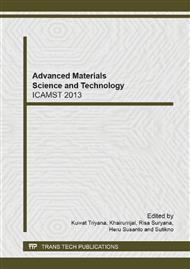p.451
p.455
p.459
p.464
p.468
p.472
p.477
p.481
p.485
Synthesized 2,4,5-Triphenylimidazole as Precursor of Organic Light Emitting Diode (OLED) Material
Abstract:
Current research based on fluorescent organic material has many advantages. One of advantages fluorescent organic material is as OLED (Organic Light Emitting Diode) based devices. OLED compound is rigid conjugated organic molecules. 2,4,5-triphenylimidazole (3) was synthesized by microwave assisted organic synthesis method. The first stage of synthesis is the synthesis of bibenzoyl (2) produced from the solventless oxidation reaction of benzoin (1) by atmospheric oxygen using MAOS (Microwave Assisted Organic Synthesis) method with chemical yields of 99.18% and melting point of bibenzoyl is 94-95 °C, and the FTIR spectrum showed the lost of -OH group peak at 3425.51 cm-1 and the strengthening of group C=O peak at 1672.25 cm-1. compound (3) was synthesized from the reactions between compound (2), benzaldehyde, ammonium acetate and acetic acid glacial by MAOS method with chemical yields of 69.04%. Melting point of compound (3) is 267-268°C and FTIR spectrum showed -NH group peak at 3038.53 cm-1 and C-N group peak at 1209.51 cm-1. Result of elucidation by 1H-NMR measurements of compound (3) showed a typical signal of -NH proton at chemical shifts of 9.31 ppm and the phenyl protons in the chemical shifts range of 7.46 to 7.94 ppm. UV-Vis and fluorescence spectra shown compound (3) has a potential as precursor compound of Organic Light Emitting Diode material.
Info:
Periodical:
Pages:
468-471
Citation:
Online since:
February 2014
Authors:
Price:
Сopyright:
© 2014 Trans Tech Publications Ltd. All Rights Reserved
Share:
Citation:


